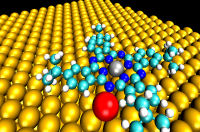Home > Press > New rotors could help develop nanoscale generators
 |
| The research focused on rotating magnetic fields which play an important part in machines such as electric motors |
Abstract:
Scientists at the University of Liverpool have developed a molecular structure that could help create current-generating machines at the nanoscale.
New rotors could help develop nanoscale generators
Liverpool, UK | Posted on June 1st, 2009In collaboration with the Chinese Academy of Sciences in Beijing, scientists have investigated the rotation of molecules on a fixed surface to understand how they may help in the development of future rotor-based machinery at nanoscale level.
The research focused on rotating magnetic fields, which play an important part in machines, such as electric motors and generators. The difficulty for technology at the atomic scale is to replicate this property with rotors the size of small molecules. A number of rotating molecules have already been identified, but so far molecules have not been used to create rotating magnetic fields.
The researchers used a gold metal surface to anchor phthalocyanine molecules, which have a metallic centre, in a large array. The anchor point - a single gold atom on top of the gold surface, and attached to a nitrogen atom of the molecule - allowed the molecules to rotate just off-centre.
Professor Werner Hofer, from the University's School of Chemistry, explains: "The difficulty in creating molecular rotors is that molecules need a fixed anchor point and will often react with the surface you want to fix them to. A gold surface interacts very weakly with molecules; it moreover provides regular anchor points to attach single molecules, which then line up in large and well ordered arrays."
"The centre atoms, which are metallic, spin around the gold atoms creating an off-axis rotation. The beauty of phthalocyanine is that the centre can be functionalised with any metal atom; the research could then lead to the development of rotating magnetic fields at a very small scale."
Scientists believe that this could be the first step towards the fabrication of machines for the generation of currents at small scale.
The research is published in Physical Review letters.
####
About University of Liverpool
The University of Liverpool is a world leading research university. Its history dates back to 1881 and the establishment of University College Liverpool. Today, the University continues to expand its teaching and research with centres of excellence in areas such as medicine, engineering and veterinary science. It is a member of the Russell Group, the association of the UK's top 20 research-led universities.
For more information, please click here
Contacts:
Kate Spark
Media Relations Manager
Phone: work +44 (0) 151 794 2247
Out of hours (cell+44 (0) 7970 247391)
Samantha Martin
Senior Press Officer
Phone: work +44 (0) 151 794 2248
Out of hours (cell+44 (0) 7973 247836)
Copyright © University of Liverpool
If you have a comment, please Contact us.Issuers of news releases, not 7th Wave, Inc. or Nanotechnology Now, are solely responsible for the accuracy of the content.
| Related News Press |
News and information
![]() Simulating magnetization in a Heisenberg quantum spin chain April 5th, 2024
Simulating magnetization in a Heisenberg quantum spin chain April 5th, 2024
![]() NRL charters Navy’s quantum inertial navigation path to reduce drift April 5th, 2024
NRL charters Navy’s quantum inertial navigation path to reduce drift April 5th, 2024
![]() Discovery points path to flash-like memory for storing qubits: Rice find could hasten development of nonvolatile quantum memory April 5th, 2024
Discovery points path to flash-like memory for storing qubits: Rice find could hasten development of nonvolatile quantum memory April 5th, 2024
Possible Futures
![]() Discovery points path to flash-like memory for storing qubits: Rice find could hasten development of nonvolatile quantum memory April 5th, 2024
Discovery points path to flash-like memory for storing qubits: Rice find could hasten development of nonvolatile quantum memory April 5th, 2024
![]() With VECSELs towards the quantum internet Fraunhofer: IAF achieves record output power with VECSEL for quantum frequency converters April 5th, 2024
With VECSELs towards the quantum internet Fraunhofer: IAF achieves record output power with VECSEL for quantum frequency converters April 5th, 2024
Molecular Machines
![]() First electric nanomotor made from DNA material: Synthetic rotary motors at the nanoscale perform mechanical work July 22nd, 2022
First electric nanomotor made from DNA material: Synthetic rotary motors at the nanoscale perform mechanical work July 22nd, 2022
![]() Nanotech scientists create world's smallest origami bird March 17th, 2021
Nanotech scientists create world's smallest origami bird March 17th, 2021
![]() Giant nanomachine aids the immune system: Theoretical chemistry August 28th, 2020
Giant nanomachine aids the immune system: Theoretical chemistry August 28th, 2020
Molecular Nanotechnology
![]() Scientists push the boundaries of manipulating light at the submicroscopic level March 3rd, 2023
Scientists push the boundaries of manipulating light at the submicroscopic level March 3rd, 2023
![]() First electric nanomotor made from DNA material: Synthetic rotary motors at the nanoscale perform mechanical work July 22nd, 2022
First electric nanomotor made from DNA material: Synthetic rotary motors at the nanoscale perform mechanical work July 22nd, 2022
![]() Nanotech scientists create world's smallest origami bird March 17th, 2021
Nanotech scientists create world's smallest origami bird March 17th, 2021
Announcements
![]() NRL charters Navy’s quantum inertial navigation path to reduce drift April 5th, 2024
NRL charters Navy’s quantum inertial navigation path to reduce drift April 5th, 2024
![]() Discovery points path to flash-like memory for storing qubits: Rice find could hasten development of nonvolatile quantum memory April 5th, 2024
Discovery points path to flash-like memory for storing qubits: Rice find could hasten development of nonvolatile quantum memory April 5th, 2024
|
|
||
|
|
||
| The latest news from around the world, FREE | ||
|
|
||
|
|
||
| Premium Products | ||
|
|
||
|
Only the news you want to read!
Learn More |
||
|
|
||
|
Full-service, expert consulting
Learn More |
||
|
|
||








